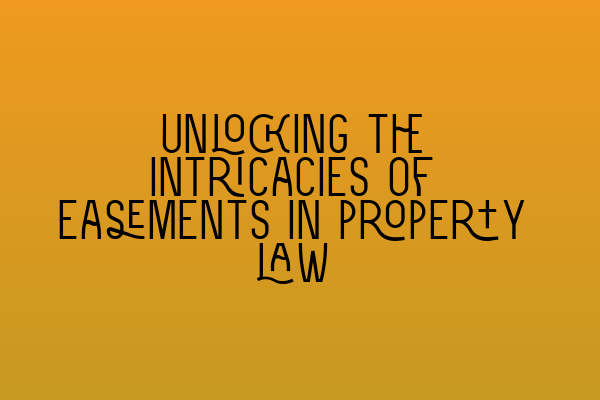Unlocking the Intricacies of Easements in Property Law
As a property owner or someone interested in property law, it is essential to understand the various rights and restrictions that come with owning a piece of land. One key concept that often arises in property law is that of easements. Easements can have a significant impact on property rights and should be understood thoroughly to ensure sound decision-making in property transactions. In this article, we will delve deep into easements and unravel the intricacies surrounding them.
What is an Easement?
An easement is a legal right that allows a person (known as the “beneficiary” or “dominant owner”) to use or enjoy someone else’s property (known as the “servient tenement”) for a specified purpose. It is important to note that an easement does not grant ownership but rather a limited right to use the property for a specific purpose.
Types of Easements
There are various types of easements, each with its own distinct characteristics and requirements. Let’s explore some of the most common types:
1. Express Easements: These easements are created through a written agreement between the dominant and servient owners. The agreement is commonly known as an easement deed or grant. Express easements should contain clear language outlining the rights and obligations of both parties.
2. Implied Easements: Unlike express easements, implied easements are not created through a written agreement. Instead, they arise by implication based on the circumstances surrounding the property. For example, if an owner sells a piece of land that is landlocked and only accessible through another property, an implied easement may arise to grant the new owner the right to cross the neighboring land for access.
3. Easements by Necessity: Easements by necessity are similar to implied easements, but they arise in situations where there is an absolute need for the easement. For example, if a property is divided into two parcels, and one parcel has no access to the public road, an easement by necessity may be established to ensure the landlocked parcel can be accessed.
4. Easements by Prescription: Easements by prescription, also known as prescriptive easements, are acquired through continuous and uninterrupted use of someone else’s property for a specified period without the owner’s permission. The period required to acquire a prescriptive easement varies by jurisdiction but often ranges from 10 to 20 years.
5. Easements by Estoppel: Easements by estoppel arise when the owner of a property leads someone to believe they have an easement and the person relies on that belief to their detriment. For example, if a property owner consistently allows their neighbor to walk across their land, the neighbor may acquire an easement by estoppel if they rely on that access and make improvements based on it.
It is important to understand the specific requirements and legal implications of each type of easement. Consulting with a qualified property law solicitor can help ensure a thorough understanding of the easements in question.
Creation and Termination of Easements
Easements can be created and terminated through various means. The creation of an easement typically involves the execution of a legal document, such as an easement deed or grant, which outlines the rights and responsibilities of the parties involved.
Termination of easements can occur through several methods, including:
1. Merger: If the dominant and servient properties become owned by the same person or entity, the easement may be terminated through merger. In such cases, there is no longer a need for an easement as the owner has full control over both properties.
2. Release: An easement can be terminated if the beneficiary voluntarily releases their rights to the easement. This typically requires a written release document signed by the beneficiary and recorded with the appropriate authorities.
3. Abandonment: If the beneficiary stops using the easement for an extended period, the easement may be considered abandoned and terminated. However, the exact length of abandonment required to terminate an easement may vary depending on local laws.
4. Estoppel: Similar to the creation of easements by estoppel, an easement can be terminated if the owner of the servient property leads someone to believe they no longer have the easement rights, and that person relies on that belief to their detriment.
Seeking Professional Assistance
Navigating the intricacies of easements in property law can be complex and time-consuming. That’s why it is crucial to seek expert legal advice from a solicitor specializing in property law. At SQE Property Law & Land Law, our team of experienced solicitors is well-versed in all aspects of property law, including easements. Whether you are dealing with the creation, modification, or termination of an easement, we can provide expert guidance and ensure your rights are protected.
Additionally, if you’re currently preparing for your SQE 1 or SQE 2 exams, our comprehensive preparation courses can help you succeed. Don’t miss out on our practice exam questions and mock exams to test your knowledge and improve your chances of passing.
To stay up-to-date with the latest property law news and information, be sure to check our website regularly. And if you have any questions or require legal assistance, do not hesitate to contact us. Our dedicated team is here to assist you every step of the way.
SRA SQE Exam Dates.
SQE 1 Practice Exam Questions.
SQE 1 Practice Mocks FLK1 FLK2.
SQE 1 Preparation Courses.
SQE 2 Preparation Courses.
